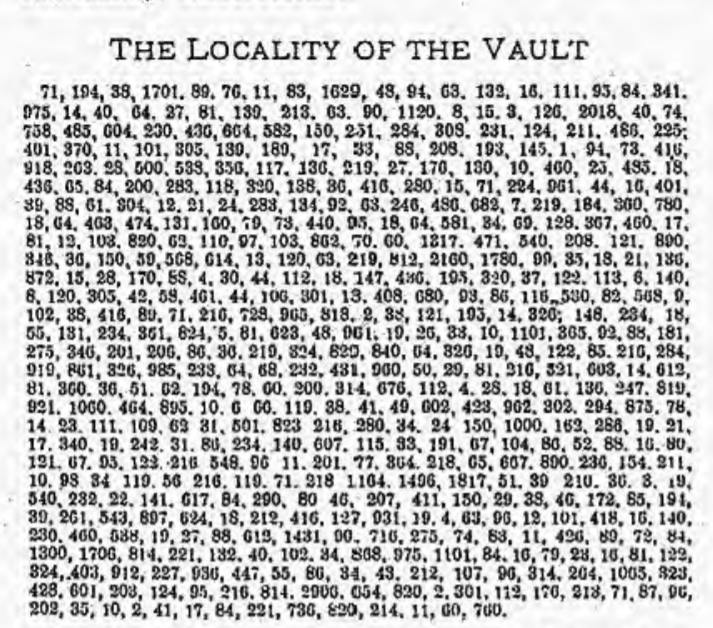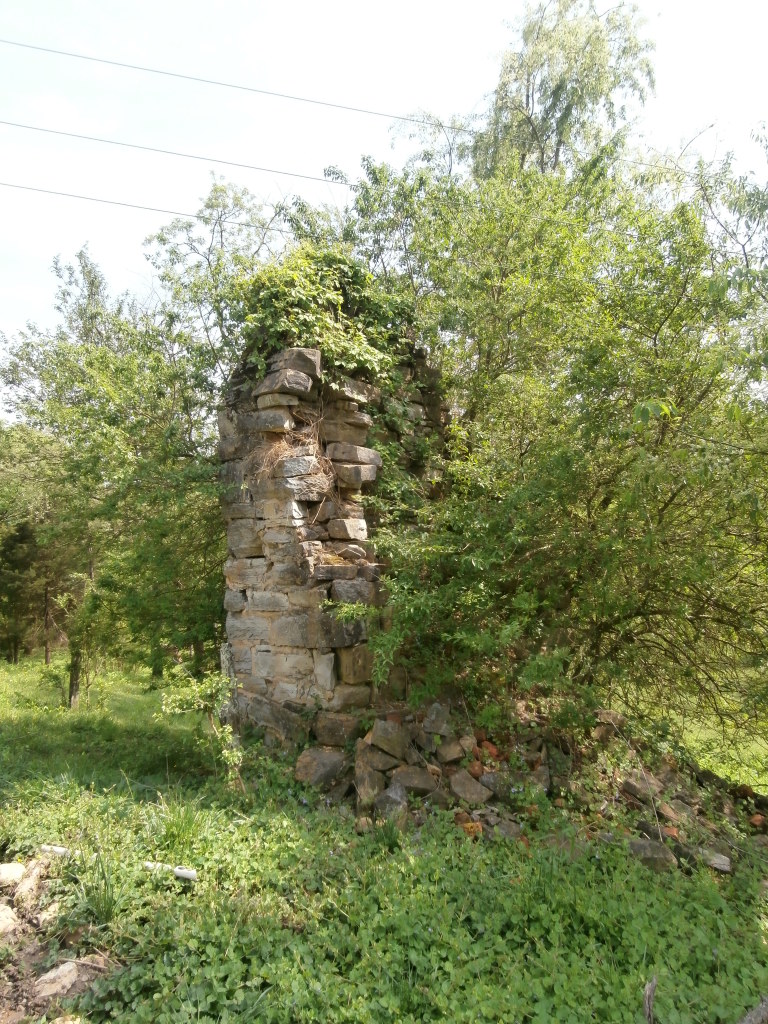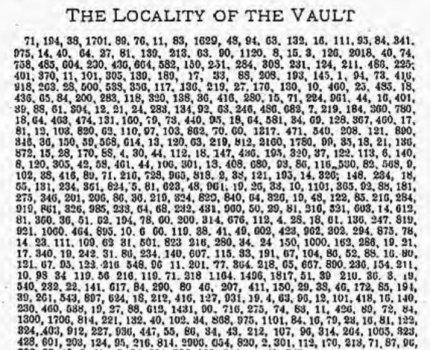
In 1885 a pamphlet was published which released to the public for the first time a story about an incredible treasure being buried somewhere in Bedford County, Virginia. It was entitled The Beale Papers.
The tale was introduced by J. B. Ward, and included copies of unsolved codes, letters and statements from persons involved in incidents described within, and an account of how through the last few decades only one of the three numerical codes had been solved. Despite much effort, this wasn’t enough. Help was needed to decode the other two Beale Codes in order to find the treasure. Such was the reason for printing the curious pamphlet of The Beale Papers.
Within The Beale Papers were copies of the codes and an explanation on how one was solved. It shared ‘Beale Paper #2’ was decoded by using a copy of the Declaration of Independence as a Key. Each word had been numbered in the Declaration, and then the numbers of Beale Paper #2 were found to connect to the first letter of the corresponding numbered word, revealing a message. The decoded text read:

“I have deposited in the county of Bedford, about four miles from Buford’s, in an excavation or vault, six feet below the surface of the ground, the following articles, belonging jointly to the parties whose names are given in number “3” herewith; The first deposit consisted of one thousand and fourteen pounds of gold, and three thousand eight hundred and twelve pounds of silver, deposited November, 1819. The second was made December, 1821, and consisted of nineteen hundred and seven pounds of gold, and twelve hundred and eighty eight pounds of silver; also jewels, obtained in St. Louis in exchange for silver to save transportation, and valued at 13,000. The above is securely packed in iron pots, with iron covers. The vault is roughly lined with stone, and the vessels rest on solid stone, and are covered with others. Paper number “1” describes the exact locality of the vault, so that no difficulty will be had in finding it.”
The Declaration of Independence is not used as the Key, at least in the same way, for ‘Beale Papers #1 and #3. When applying the method used for ‘Beale Paper #2’, each yielded gibberish.
Since the pamphlet’s release, numerous treasure hunters and cryptographers, both amateur and professional have given their attention to the Beale Papers. Without any success attained by any of them, the question began to arise, ‘Are The Beale Papers even real, or might the story of buried treasure be all a hoax?’ The question suggesting the unsolved codes could be random numbers and a hidden message will never be found from them!
Consideration was then given to determine if the numbers of Beale Paper #1 and #3 were random, and if Beale Paper #2 was used to only perpetuate the hoax. In 1970, the National Security Agency, shared their findings on the matter. After much analysis by a group from the agency a few conclusions were made on the numbers of The Beale Papers. They are:
- 1)The Beale Papers 1 and 3 are ‘for real’. They are not random doodles but do contain intelligence and messages of some sort. Further attempts at decoding are indeed warranted.
- 2)The method used for encoding Beale Papers 1 and 3 is similar to that used for Beale Paper 2. It is very probable that a letter-counting, rather than a word-counting method was used. If it was indeed a letter-count, then spaces between letters and punctuation marks were not included in the count.
- 3)The basic text used for encoding Beale Papers 1 and 3 is not Latin. There is enough evidence to assume it was English.
These conclusions were obtained through analysis on whether the numbers of The Beale Papers had uniform distribution, frequency, and other indicators of randomness.
Beale Paper #1 consists of 520 numbers ranging from 1 to 2906. Beale Paper #2 is the longest of the three with 763 numbers ranging from 1 to 994. Beale Paper #3 consists of 618 numbers ranging from 1 to 975.
Each of these were found to have similar signatures and certain tests done on them indicated they were not random. For instance, a look at what was called run ups and downs revealed with high certainty the numbers of The Beale Papers followed a process of the person creating the code. It revealed the creator most likely started at the top of the document, worked himself down, and then jumped back up, to go down again. If the numbers were randomly picked, the lengths of the run downs would be much less than what The Beale Papers demonstrated.
The above study was performed only on the numbers. It did not delve into the accuracy of the story or written details of The Beale Papers. It’s known there are questions of credibility when looking at that part of the this whole remarkable tale.
However, it seems from the above conclusions on analysis done on the Beale Papers, messages should be able to be decoded if the correct Key or method is found in order to do so. What might they say?
More on The Beale Papers to come!
Best of luck with all that you seek! Always Treasure the Adventure!

